《牛津小学英语5A》全册教案
牛津小学英语5a教案

牛津小学英语5A教案一、教学目标1.能够听、说、读、写并理解牛津小学英语5A教材中的单词和句子。
2.能够正确运用所学知识进行简单的对话和交流。
3.培养学生的听、说、读、写和思维能力,提高他们的英语综合应用能力。
二、教学内容Unit 1: My school•熟悉学校的英文表达,如:classroom, library, playground, etc。
•学习与学校相关的字母拼读和单词,如:A, B, C, school, book, pen, etc。
•学习日常用语,如:What’s this? It’s a book. Thank you. No problem, etc。
Unit 2: My family•学习家庭成员的称呼和表述,如:father, mother, brother, sister, etc。
•学习描述家庭成员特征的形容词,如:big, small, tall, short, etc。
•学习用英语对家庭成员进行简单介绍。
Unit 3: At the zoo•学习动物的英文表达,如:elephant, lion, monkey, etc。
•学习描述动物特征的形容词,如:big, small, long, short, etc。
•学习用英语描述动物的行为和习性。
三、教学步骤Unit 1: My school1.引入学校的英文表达:展示图片,引导学生说出学校中的不同场所和事物的英文名称。
– e.g. Classroom– e.g. Library– e.g. Playground2.讲解字母拼读和单词:通过图片和卡片的方式,教授与学校相关的字母拼读和单词。
– e.g. A - apple– e.g. B - book– e.g. C - classroom3.进行简单对话练习:使用所学的单词和句子进行简单的对话练习,鼓励学生互相交流和问答。
–A: What’s this?–B: It’s a book.–A: Thank you.–B: No problem.Unit 2: My family1.引入家庭成员的称呼和表述:展示图片,引导学生说出不同家庭成员的英文称呼和描述。
牛津上海版小学五年级上册5A教案[全册].docx
![牛津上海版小学五年级上册5A教案[全册].docx](https://img.taocdn.com/s3/m/b944c51ed5bbfd0a7856735a.png)
5AM1U1 My b让thday 单元设计()>单元任务分析该单元的主题为My birthday,要求学生掌握的核心词汇是序数词:first、second> thirds fourth、fifth> sixth等,让学生会用序数词正确表达日期,如:the fourth of October«还可根据学生的具体情况拓展序数词的使用。
主要句型是When' s…birthday?及冋答It' s on the-of-o要求学生能以我的生日为主题,进行时间、内容、地点等的问答,邀请函的设计等。
除了核心词Z外,本单元还需要复习再现有关月份、星期、时间等的表达。
另外,需要常握和操练的词汇和词组包括bring some orange things to the party> make a birthday invitation、make hats等,这些词组在日常交流中实际使用价值较大,可结合学生的实际情况进行教学,使学生可以做到运用这些词汇进行流利地交流。
音标教学方面,对[i:][l]进行发音的归类,让学生能看到音标想到字母或字母组合。
在情感表达方而,生日主题侧重通过邀请卡的书写,生日相关时间、地点、主题的问答,生日聚会的开展营造生日前和生日屮的愉快氛围。
本单元的故事教学是生日主题的延续,通过讲述父亲的辛苦工作及生日时收到父亲亲手制作的礼物的兴奋,旨在SZ习巩固新旧知识的同时,教育孩子懂得感恩。
>单元教学目标通过本单元的学习,学生能:1.掌握序数词:first、second^ third、fourth> fifth> sixth .........................掌握单词:patty、begin、bring> wcar> favourite2.掌握句型:When' s …birthday? It' s on the・・・of…The sounds interesting. I can' t wait.3.复习巩固月份、星期、服饰的单词和词组及时间表达法。
牛津小学英语5A教案——Unit优秀3篇

牛津小学英语5A教案——Unit优秀3篇牛津小学英语5A教案——Unit 篇一unit 2 a new house第一教时一、教学内容5a 第二单元第一教时(read and say)二、教学目标1、能正确理解、掌握对话内容、并能朗读、初步表演对话。
2、能正确地听、说、读、写词汇a study、 a bedroom、a wall、a door、a bed3、能正确地听、说、读、词汇large、 beside、between、live4、能正确地听、说、读、句型what's in / on / under / beside / behind/between…? there's a /an… in /on/under/beside/behind/between…there aresome…in/on/under/beside/behind/between…there isn't a/an… there aren't any …三、教学重点:能正确理解、掌握对话内容、并能朗读、初步表演对话。
四、教学难点:能比较流畅地朗读对话并能在掌握对话内容的基础上进一步表演对话。
五、教学准备:1、教师准备校园、家庭平面图等。
2、录音机、磁带。
3、学生准备一张家庭平面图。
六、教学过程:a revision1. free talkglad to see you. it's the fifth day of the new term…2. 课件出示unit 1课文图片进行问答what's in your school? there is a building in my school.how many classrooms are there ? there are …is there a sports hall? yes / noare there any reading rooms in the building? yes, there are /no, there aren't .where're the computer rooms? they 're on the second floor.…b presentation and practice出示课件yang ling家的新居平面图进行问答1. 复习单词a bathroom, a bedroom, a study, a kitchen, a dining-room, a sitting-room.2. 借助图片,教师描述新居的情况。
牛津小学英语5a教案
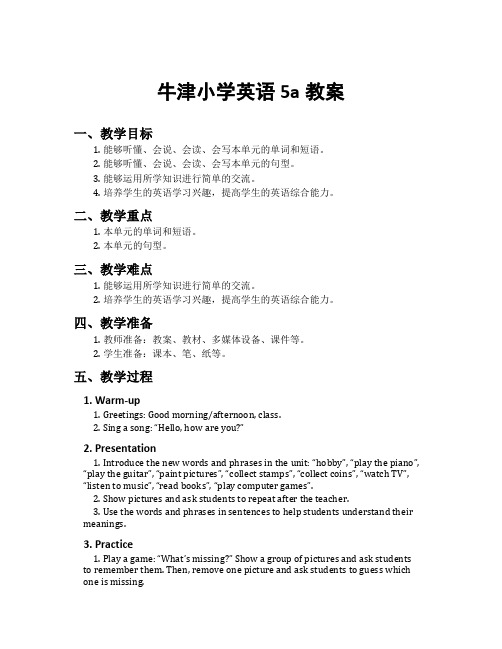
牛津小学英语5a教案一、教学目标1.能够听懂、会说、会读、会写本单元的单词和短语。
2.能够听懂、会说、会读、会写本单元的句型。
3.能够运用所学知识进行简单的交流。
4.培养学生的英语学习兴趣,提高学生的英语综合能力。
二、教学重点1.本单元的单词和短语。
2.本单元的句型。
三、教学难点1.能够运用所学知识进行简单的交流。
2.培养学生的英语学习兴趣,提高学生的英语综合能力。
四、教学准备1.教师准备:教案、教材、多媒体设备、课件等。
2.学生准备:课本、笔、纸等。
五、教学过程1. Warm-up1.Greetings: Good morning/afternoon, class.2.Sing a song: “Hello, how are you?”2. Presentation1.Introduce the new words and phrases in the unit: “hobby”, “play the piano”, “play the guitar”, “paint pictures”, “collect stamps”, “collect coins”, “watch TV”, “listen to music”, “read books”, “play computer games”.2.Show pictures and ask students to repeat after the teacher.e the words and phrases in sentences to help students understand their meanings.3. Practice1.Play a game: “What’s missing?” Show a group of pictures and ask students to remember them. Then, remove one picture and ask students to guess which one is missing.2.Ask students to work in pairs and talk about their hobbies using the new words and phrases they have learned.3.Have students read the dialogue in the textbook and practice it in pairs.4. Production1.Ask students to make a poster about their hobbies using the new words and phrases they have learned.2.Have students present their posters to the class and talk about their hobbies.5. Review1.Review the new words and phrases in the unit.2.Review the dialogue in the textbook.3.Play a game: “Word chain”. The first student says a word, and the next student says a word that starts with the last letter of the previous word.6. Homework1.Review the new words and phrases in the unit.2.Write a short paragraph about your hobbies.六、教学反思本节课主要介绍了本单元的单词和短语以及句型,并通过游戏、对话、海报等形式进行了练习和巩固。
上海牛津英语5A全部教案

上海牛津英语5A全部教案Unit 1: Hello!Lesson 1: GreetingsLearning Objectives- Understand and use greetings in English- Respond to different greetings appropriately - Introduce themselves in EnglishKey Vocabulary- Hello-Hi- Good morning- Good afternoon- Good evening- How are you?- I'm fine, thank you.- What's your name?- My name is...- Nice to meet you.Teaching Procedure1. Warm-up (5 minutes)- Greet the students in English by saying "Good morning!" and asking "How are you?"- Encourage the students to respond with "Good morning!" and "I'm fine, thank you. How are you?"2. Presentation (10 minutes)- Introduce the new vocabulary by showing flashcards or pictures of greetings.- Model the pronunciation and ask the students to repeat after you.- Use gestures or actions to help convey the meanings of the words.- Practice saying different greetings with the students.3. Practice (15 minutes)- Divide the class into pairs or small groups.- Have the students take turns greeting each other and responding with appropriate expressions.- Walk around the classroom and provide assistance as needed.4. Production (15 minutes)- Have the students form a circle with their chairs.- Each student should introduce themselves by saying "Hello, my name is... Nice to meet you."- Encourage the students to ask each other "What's your name?" and respond with "My name is..." and "Nice to meet you."5. Consolidation (5 minutes)- Recap the new vocabulary and expressions learned in the lesson.- Have a class discussion about the importance of greetings in different cultures.6. Follow-up Activity (Optional)- Divide the class into two teams.- Play a game where each team takes turns greeting the other team in English.- Award points for correct greetings and responses.Unit 2: My DayLesson 1: Daily RoutineLearning Objectives- Understand and use vocabulary related to daily routines- Describe their own daily routines in English- Ask and answer questions about daily routinesKey Vocabulary- get up- have breakfast- go to school- have lunch- do homework- play games- have dinner- go to bedTeaching Procedure1. Warm-up (5 minutes)- Review the vocabulary from the previous lesson on greetings.- Play a quick game of Simon Says using the greetings and responses.- For example: Say "Simon says 'Good morning!'" and the students should respond with "Good morning!"2. Presentation (10 minutes)- Introduce the new vocabulary by showing pictures or flashcards of daily routines.- Model the pronunciation and ask the students to repeat after you.- Use gestures or actions to help convey the meanings of the words.- Practice saying different daily routines with the students.3. Practice (15 minutes)- Divide the class into pairs or small groups.- Have the students take turns asking and answering questions about their daily routines.- Encourage them to use the new vocabulary and expressions.4. Production (15 minutes)- Have the students work in pairs to create and performshort dialogues about their daily routines.- Each pair should write a simple dialogue using the new vocabulary and perform it in front of the class.- Provide feedback and encouragement to each group.5. Consolidation (5 minutes)- Recap the new vocabulary and expressions learned in the lesson.- Have a class discussion about the students' favorite parts of their daily routines.6. Follow-up Activity (Optional)- Have the students draw a picture or write a short paragraph describing their ideal daily routine.- They should use the new vocabulary and expressions learned in the lesson.。
《牛津小学英语5A》教案(通用6篇)

《牛津小学英语5A》教案(通用6篇)《牛津小学英语5A》篇1《牛津小学英语5a》第一单元第一教时教学目标:1. 复习巩固四年级所学知识。
2. 能掌握词汇first, second, third... building, day, all, happy, glad, again3. 能正确运用对话中的日常交际用语。
4. 初步理解和掌握课文第一段:it is the first day of the new term.all the students are back at school.they are happy to see each other again.教具准备:l 录音机和磁带l 课文挂图l 歌曲“two jackets”教学过程:1.listen and sing a song “two jackets”2.free talka. revision.b. greetings.welcome back to school.nice to meet you.(according to the real situation, the students practise )then moving to the sentence glad to see you. (students practise)2.presentation and practicet: what day is it today?s: it’s monday.t: what’s the date tod ay?it’s september 1st.it’s the first day of the new term.(new words: first, day, term)(amplify the structure of “the first ... of the…” )i’m happy. today all the students are back at school.glad to see you.we are happy to see each other again.(new words: all, back, back at school, glad, again, each other) (read and practice them, eg: read, make phrases, etc.)(according to the situation, let the students understand the meaning of the key sentences.)3.look at the picture of the text and answer the questions. (making clear the background)4.a. read and say (paragraph 1)1) listen to the tape2) read after the tape3) read by together5.look at picture 2 , review “there is...”t: there is a new building in the picture.(new word: building)t: how many floors are there in this building?s: four.(new word: floor)learn the name of “the ground floor/the first floor/ the second floor...”t: what’s the name of the rooms in this building? we will learn them next class.6.homework1) talk about our school2) copy the new words3) some translations第二教时教学目标:1. 复习四年级相关知识 a computer room, a music room, a tape recorder, a desk, a chair等。
《牛津小学英语5A》教案推荐六篇
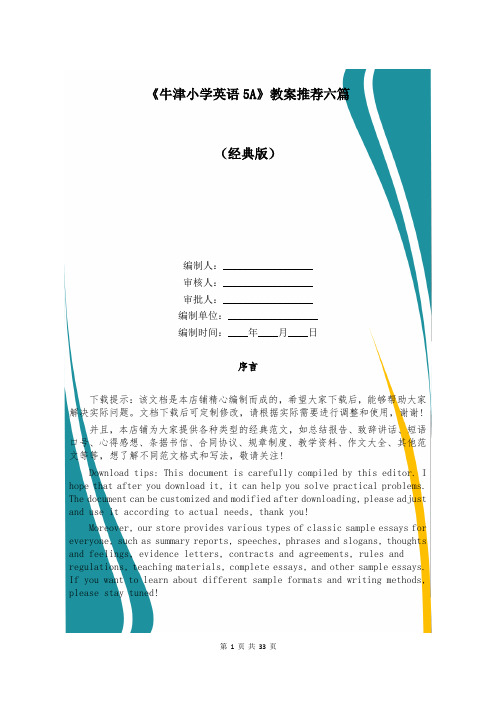
《牛津小学英语5A》教案推荐六篇(经典版)编制人:__________________审核人:__________________审批人:__________________编制单位:__________________编制时间:____年____月____日序言下载提示:该文档是本店铺精心编制而成的,希望大家下载后,能够帮助大家解决实际问题。
文档下载后可定制修改,请根据实际需要进行调整和使用,谢谢!并且,本店铺为大家提供各种类型的经典范文,如总结报告、致辞讲话、短语口号、心得感想、条据书信、合同协议、规章制度、教学资料、作文大全、其他范文等等,想了解不同范文格式和写法,敬请关注!Download tips: This document is carefully compiled by this editor. I hope that after you download it, it can help you solve practical problems. The document can be customized and modified after downloading, please adjust and use it according to actual needs, thank you!Moreover, our store provides various types of classic sample essays for everyone, such as summary reports, speeches, phrases and slogans, thoughts and feelings, evidence letters, contracts and agreements, rules and regulations, teaching materials, complete essays, and other sample essays. If you want to learn about different sample formats and writing methods, please stay tuned!《牛津小学英语5A》教案推荐六篇《牛津小学英语5A》教案篇1课题unit 3 at a music lesson第二课时(新授课)课时教学目标1、认知:(1)能听说读写词汇a lesson, learn。
牛津英语5A教案
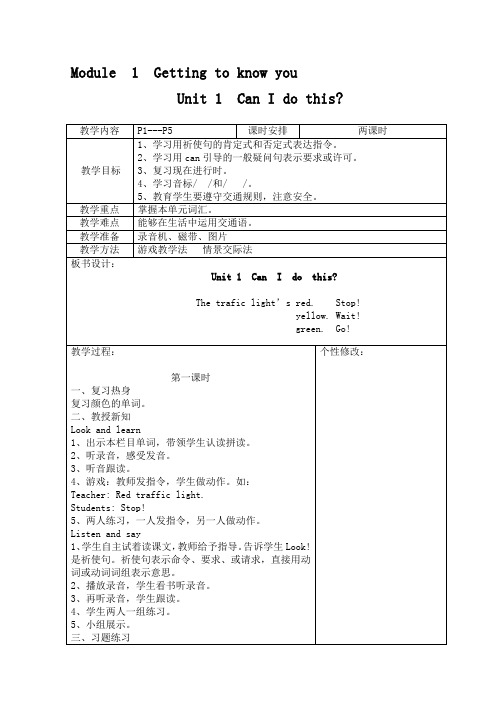
Module 1 Getting to know youUnit 1 Can I do this?Unit 2 This is what I wantUnit 3 This is what I needModule 2 Me,my family and friendsUnit 1 MeUnit 2 What do you like?Unit 3 A birthday partyModule 3 Places and activitiesUnit 1 My schoolUnit 2 Let’s go shopping!Unit 3 Follow the signs!Module 4 The natural worldUnit 1 Wild animalsUnit 2 ButterfliesUnit3 Parks and places in China班级姓名一、选出每组中划线部分发音与其它单词不同的一项。
(14分)1.() A. she B. bee C. bin2.() A. sweet B. sit C. list3.() A. read B. this C. sea4.() A. bed B. head C. hand5.() A. back B. apple C. sweater6.() A. lend B. land C . cat7.() A. any B. many C. black二、为下列单词添加正确的首字母。
(30分)1. oad2. ross3. tation4. lue5. ant6. icnic7. ock8. eed9. top 10. niform三、选择适当的词,将下列句子补充完整。
(16分)have Stop wants and Thank What Don’t for1. Look! The traffic light’s red. !2. Can I some sweets?3. do you want?4. open the window.5. Alice some oranges juice.6. you very much.7. What do you need school.8. I want some paper felt pen.四、读一读,连一连。
牛津小学英语5A全册教案

1.分组竞赛:
学生看、听教师课前作好的课件。小组比赛,用Is there /Are there…?There's/Therse are…How many…are there?进行小组竞赛,比一比哪一组能说出最多对话。教师在竞赛后表扬积极参与的学生。
2.练习册听力
四、Assign homework
4.正确的听、说、读、写句型Is there a…? Yes, there is. / No, there isn't. Are there any…? Yes, there are? / No, there aren't. How many…are there? There are…
5.能正确地运用对话中的日常交际用语和三会句型It is the first day of…They are happy to each other. Glad to see you. I'm not sure. It's / They're on the…floor.
2. T:Is there a noticeboard in our classroom?Are there any computers in our classroom.Is there a bookcase? How many…are there?
3.用Is/Are there…in our school? How many.. are there? Where is it? are they?对学生所做的本校-专用教室的调查结果进行检查,完成下表。
floor.
3.能正确的听、说、读词汇first, a term, back. each other. glad.
牛津小学英语5A教(学)案(全册)
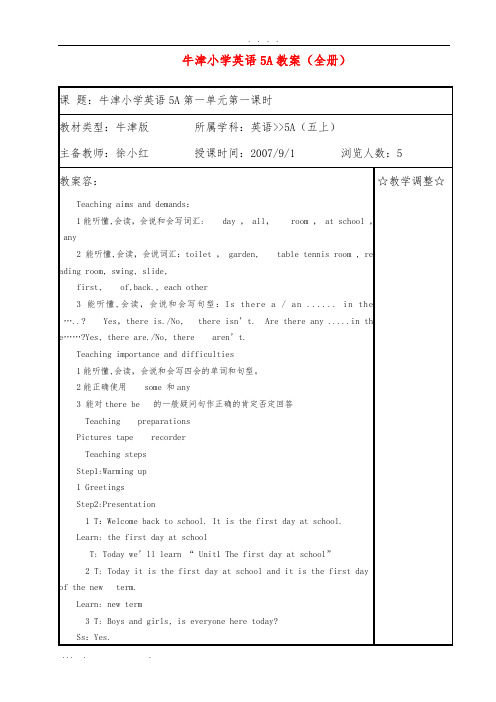
课 题:牛津小学英语5A第一单元第一课时
教材类型:牛津版 所属学科:英语>>5A(五上)
主备教师:徐小红 授课时间:2007/9/1 浏览人数:5
教案容:
Teaching aims and demands:
1能听懂,会读,会说和会写词汇: day , all, room , at school , any
Ss: There are …… toilets in our school.
Learn: swing slide as the same way
5 (1) T: What’s in the school?
S: There is a/an……
There are some…..
(2).T: (去掉图片) Is there ………?
2 能听懂,会读,会说词汇:toilet , garden, table tennis room , reading room, swing, slide,
first, of,back., each other
3 能听懂,会读,会说和会写句型:Is there a / an ...... in the …..? Yes,there is./No, there isn’t. Are there any .....in the……?Yes, there are./No, there aren’t.
There are some classrooms.( 改一般疑问句并作否定回答)
☆教学调整☆
教学反思:
课 题:牛津小学英语5A第一单元第二课时
教材类型:牛津版 所属学科:英语>>5A(五上)
主备教师:徐小红 授课时间:2007/9/3 浏览人数:5
牛津小学英语5a教案

牛津小学英语5A教案一、教学目标通过本节课的学习,学生能够: - 掌握英语单词和短语的发音和拼写; - 能够运用目标语言进行简单的对话,并正确使用句型; - 意识到学习英语的重要性,并主动参与到课堂活动中。
二、教学准备•教材:牛津小学英语5A教材•多媒体设备:投影仪、音响等•教学辅助工具:图片、卡片、单词卡片等三、教学过程1. 导入新课(5分钟)在教室的黑板上展示本课的主题图片,并引导学生观察图片,用英语描述图片中的内容,激发学生的学习兴趣。
然后通过问题的提问方式,引导学生猜测本节课的主题。
2. 新课讲解(15分钟)通过多媒体展示教材中相关的图片和短语,并辅以手势和肢体语言的示范,引导学生学习新课的内容。
同时,利用黑板或白板,将重点单词和短语写在上面,让学生跟读,巩固记忆。
3. 听力训练(20分钟)播放录音,让学生听录音,并在听录音的过程中完成相关的听力练习,例如根据听力内容选择正确的图片或回答问题。
接着,教师与学生进行听力对话,引导学生正确理解听力内容,并提高学生对听力的理解和反应速度。
4. 语言操练(20分钟)教师设计一系列语言操练活动,例如短语匹配、句子填空等,让学生运用所学的语言进行对话和操练,培养学生的口语表达能力。
同时,教师可分组让学生之间进行对话练习,增加学生的合作和交流能力。
5. 扩展活动(15分钟)通过图片或视频展示,引导学生进行扩展活动,例如讨论与本节课话题相关的话题,开展小组活动,让学生在轻松、愉快的环境中运用所学语言,扩展学生的思维和表达能力。
6. 作业布置(5分钟)布置与本节课内容相关的作业,例如课后练习册上的练习题、口头作业等,加深学生对本节课内容的理解和记忆。
四、教学反思本节课的教学目标主要是让学生掌握新课的单词和短语,能够运用所学语言进行简单的对话。
通过多种教学手段,例如听力训练和语言操练等,提高学生的听说能力。
同时,通过扩展活动,引导学生参与互动,培养学生的合作与交流能力。
牛津小学英语5A教案

牛津小学英语5A教案牛津小学英语5A《牛津小学英语5A》第一单元第一教时教学目标:1.复习巩固四年级所学知识。
2.能掌握词汇first, second, third... building, day, all, happy, glad, again3. 能正确运用对话中的日常交际用语。
4. 初步理解和掌握课文第一段:教学过程:1.Listen and sing a song “Two jackets”2.Free talk2.Presentation and practiceT: What day is it today? S: It’s Monday.T: What’s the date today?It’s September 1st.It’s the first day of the new term.(new words: first, day, term)(amplify the structure of “the first ... of the…” ) I’m happy. Today all the students are back at school. Glad to see you.We are happy to see each other again.(new words: all, back, back at school, glad,again, each other)(Read and practice them, eg: read, make phrases, etc.)(According to the situation, let the students understand the meaning of the key sentences.)3.Look at the picture of the text and answer the questions. (making clear the background)4.A. Read and say (Paragraph 1)1) Listen to the tape 2) Read after the tape 3) Read by together5.Look at Picture 2 , review “There is...”T: There is a new building in the picture.(new word: building)T: How many floors are there in this building?S: Four.(new word: floor)Learn the name of “the ground floor/the first floor/ the second floor...”T: What’s the name of the rooms in this building? We will learn them next class.6.Homework1) Talk about our school2) Copy the new words3) Some translations第二教时教学目标:1.复习四年级相关知识 a computer room, a music room, a tape recorder, a desk, a chair等。
小学牛津英语5a教案
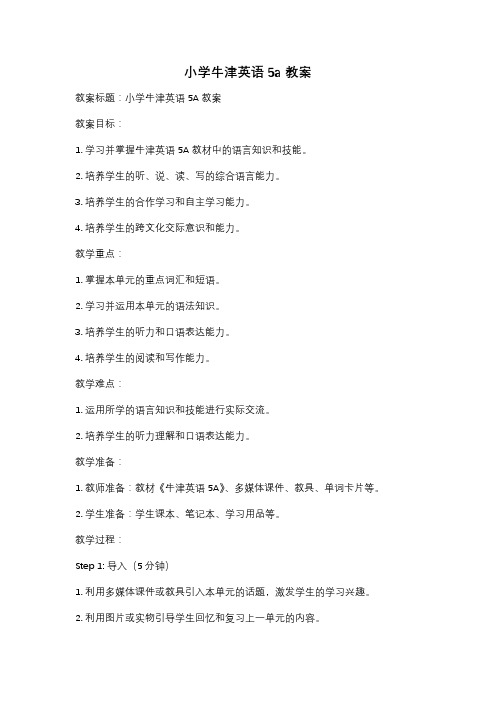
小学牛津英语5a教案教案标题:小学牛津英语5A教案教案目标:1. 学习并掌握牛津英语5A教材中的语言知识和技能。
2. 培养学生的听、说、读、写的综合语言能力。
3. 培养学生的合作学习和自主学习能力。
4. 培养学生的跨文化交际意识和能力。
教学重点:1. 掌握本单元的重点词汇和短语。
2. 学习并运用本单元的语法知识。
3. 培养学生的听力和口语表达能力。
4. 培养学生的阅读和写作能力。
教学难点:1. 运用所学的语言知识和技能进行实际交流。
2. 培养学生的听力理解和口语表达能力。
教学准备:1. 教师准备:教材《牛津英语5A》、多媒体课件、教具、单词卡片等。
2. 学生准备:学生课本、笔记本、学习用品等。
教学过程:Step 1: 导入(5分钟)1. 利用多媒体课件或教具引入本单元的话题,激发学生的学习兴趣。
2. 利用图片或实物引导学生回忆和复习上一单元的内容。
Step 2: 新课呈现(15分钟)1. 利用多媒体课件或教具呈现本单元的重点词汇和短语,并进行发音和意义的教学。
2. 引导学生通过对话、图片等形式理解并掌握新课的语法知识。
3. 帮助学生理解并掌握新课的语法规则和用法。
Step 3: 听说训练(20分钟)1. 播放录音或利用多媒体课件进行听力训练,让学生听懂并理解相关对话和文章。
2. 进行口语练习,让学生运用所学的知识进行对话或情景模拟练习。
Step 4: 读写训练(20分钟)1. 引导学生朗读课文,并进行语音、语调和语速的指导。
2. 进行阅读理解训练,帮助学生理解并回答相关问题。
3. 进行写作练习,让学生根据所学的知识写出相关的句子或短文。
Step 5: 巩固练习(15分钟)1. 利用教材或其他练习册进行相关练习,帮助学生巩固所学的知识和技能。
2. 进行小组活动或游戏,让学生在合作中运用所学的语言进行交流和表达。
Step 6: 作业布置(5分钟)1. 布置相关的课后作业,巩固学生的学习成果。
2. 鼓励学生自主学习和积极参与课外英语活动。
《牛津小学英语5A Unit8》教学设计7篇

《牛津小学英语5A Unit8》教学设计7篇《牛津小学英语5A》Unit 6教案篇一十、教学内容d fun house十一、教学目标1、能听懂、会说以下八个有关水果的三会单词bananas .watermelons , peaches, pears .apples ,oranges ,mangoes, pineapples .2 能听懂会说几种家庭成员间的称呼语father, mother, brother, sister.3、三会句型:good morning .good afternoon ,this is my …hi/hello…nice to meet you .nice to meet you , too .4 能初步了解名词复数的读音。
5能听懂并有韵律地诵读歌谣they are all very good.十二、教学重点1、能听懂、会说以下八个有关水果的三会单词bananas .watermelons , peaches, pears .apples ,oranges ,mangoes, pineapples .2 能听懂会说几种家庭成员间的称呼语father, mother, brother, sister.3、三会句型:good morning .good afternoon ,this is my …hi/hello…nice to meet you .nice to meet you , too .4 能初步了解名词复数的读音。
5 能用this is my … 句型介绍家庭成员。
6 能听懂并有韵律地诵读歌谣they are all very good.十三、教学难点1、能听懂、会说以下八个有关水果的三会单词bananas .watermelons , peaches, pears .apples ,oranges ,mangoes, pineapples .2 能听懂会说几种家庭成员间的称呼语father, mother, brother, sister.3、三会句型:good morning .good afternoon ,this is my …hi/hello…nice to meet you .nice to meet you , too .十四、教学准备1、教具准备1)关于家庭成员的照片。
牛津小学英语5a教案(优秀6篇)
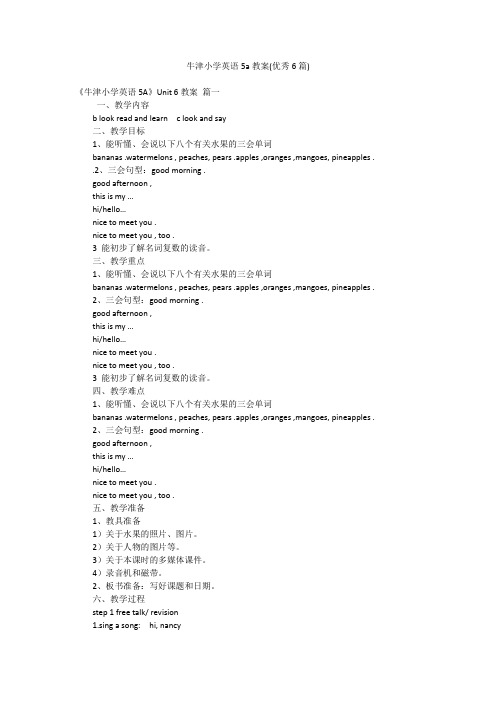
牛津小学英语5a教案(优秀6篇)《牛津小学英语5A》Unit 6教案篇一一、教学内容b look read and learnc look and say二、教学目标1、能听懂、会说以下八个有关水果的三会单词bananas .watermelons , peaches, pears .apples ,oranges ,mangoes, pineapples ..2、三会句型:good morning .good afternoon ,this is my …hi/hello…nice to meet you .nice to meet you , too .3 能初步了解名词复数的读音。
三、教学重点1、能听懂、会说以下八个有关水果的三会单词bananas .watermelons , peaches, pears .apples ,oranges ,mangoes, pineapples .2、三会句型:good morning .good afternoon ,this is my …hi/hello…nice to meet you .nice to meet you , too .3 能初步了解名词复数的读音。
四、教学难点1、能听懂、会说以下八个有关水果的三会单词bananas .watermelons , peaches, pears .apples ,oranges ,mangoes, pineapples .2、三会句型:good morning .good afternoon ,this is my …hi/hello…nice to meet you .nice to meet you , too .五、教学准备1、教具准备1)关于水果的照片、图片。
2)关于人物的图片等。
3)关于本课时的多媒体课件。
4)录音机和磁带。
2、板书准备:写好课题和日期。
六、教学过程step 1 free talk/ revision1.sing a song: hi, nancy2.greetings .(同位之间练习,自由锁链反应)。
《牛津小学英语5A》教案

《牛津小学英语5A》教案一、教材分析《牛津小学英语 5A》是小学英语学习的重要阶段,教材内容丰富多样,涵盖了词汇、语法、听说读写等多个方面。
本教材注重培养学生的英语综合运用能力,通过生动有趣的情境和活动,激发学生的学习兴趣。
教材中的词汇包括了日常生活、学校、家庭、动物等常见主题,语法知识点则逐步加深,如一般现在时、现在进行时等的基本用法。
教材中的对话和短文贴近学生生活,有助于提高学生的阅读理解和口语表达能力。
二、学情分析五年级的学生已经有了一定的英语基础,具备了初步的听说读写能力。
他们对英语学习有较高的热情,好奇心强,喜欢参与各种英语活动。
然而,部分学生在语法的理解和运用上可能还存在困难,需要更多的练习和指导。
三、教学目标1、知识目标学生能够掌握教材中的重点词汇和句型。
理解并正确运用所学的语法知识。
2、技能目标能够听懂、会说、认读教材中的对话和短文。
能够用英语进行简单的交流和表达。
3、情感目标培养学生学习英语的兴趣和积极性。
增强学生的自信心,敢于用英语表达自己的想法。
四、教学重难点1、教学重点重点词汇的记忆和运用。
关键句型的理解和操练。
语法知识点的掌握和应用。
2、教学难点复杂句型的结构和用法。
语法知识在实际语境中的灵活运用。
五、教学方法1、情景教学法通过创设生动的情境,让学生在实际情境中学习和运用英语。
设计有趣的游戏活动,激发学生的学习兴趣,巩固所学知识。
3、任务驱动法布置明确的任务,让学生在完成任务的过程中提高英语能力。
六、教学过程1、导入通过播放一段与本单元主题相关的英语歌曲或动画,引起学生的兴趣,导入新课。
2、词汇教学利用图片、实物、动作等多种方式呈现新词汇,帮助学生理解词义。
带领学生跟读、拼写词汇,进行多次重复练习。
3、句型教学结合情境,讲解重点句型的结构和用法。
让学生进行模仿操练,通过替换关键词等方式进行句型练习。
4、对话教学播放对话录音,让学生整体感知对话内容。
逐句讲解对话,帮助学生理解。
牛津小学英语5a教案

牛津小学英语5a教案教案标题:牛津小学英语5A教案教学目标:1. 通过本节课的学习,学生将能够掌握并正确运用本课时的词汇和句型。
2. 培养学生的听、说、读、写的综合语言能力。
3. 培养学生的合作意识和团队合作能力。
教学重点:1. 学习并掌握本课时的词汇和句型。
2. 培养学生的听力和口语表达能力。
教学准备:1. 牛津小学英语5A教材和课件。
2. 单词卡片和图片。
3. 录音机和录音材料。
教学过程:Step 1: Warm-up (5分钟)1. 教师与学生进行简单的问候和打招呼。
2. 通过播放一段英文歌曲或唱一首英文儿歌来热身。
Step 2: Presentation (10分钟)1. 教师呈现本课时的新词汇和句型,并通过图片或实物进行示范和解释。
2. 教师与学生一起进行词汇和句型的操练,确保学生理解并能正确运用。
Step 3: Listening (15分钟)1. 教师播放录音材料,要求学生仔细听,并根据听到的内容回答问题。
2. 教师再次播放录音材料,要求学生跟读并模仿录音中的语音语调。
Step 4: Speaking (15分钟)1. 教师分组让学生进行小组讨论,讨论关于本课时主题的问题。
2. 教师鼓励学生积极参与讨论,并提供必要的帮助和指导。
Step 5: Reading (10分钟)1. 教师布置阅读任务,让学生阅读与本课时主题相关的短文或对话。
2. 学生独立阅读,并回答相关问题。
Step 6: Writing (15分钟)1. 教师要求学生根据所学内容,完成一篇关于本课时主题的短文或写一篇简短的日记。
2. 学生完成写作任务后,可以相互交流并互相修改。
Step 7: Consolidation (5分钟)1. 教师复习本课时的重点内容,让学生回顾所学的词汇和句型。
2. 教师提供一些练习题,检查学生对所学内容的掌握情况。
Step 8: Homework (5分钟)1. 教师布置适当的作业,如复习所学内容、完成练习题或写一篇关于本课时主题的作文。
- 1、下载文档前请自行甄别文档内容的完整性,平台不提供额外的编辑、内容补充、找答案等附加服务。
- 2、"仅部分预览"的文档,不可在线预览部分如存在完整性等问题,可反馈申请退款(可完整预览的文档不适用该条件!)。
- 3、如文档侵犯您的权益,请联系客服反馈,我们会尽快为您处理(人工客服工作时间:9:00-18:30)。
牛津小学英语5A》第一单元教案Unit One The first day at school一,教学内容和要求(注:*者为教学难点,△者为教学重点.)二.教学安排:五教时三.教学过程:第一教时教学目标:1.复习巩固四年级所学知识.2.能掌握词汇first, second, third... building, day, all, happy, glad, again等.3.能正确运用对话中的日常交际用语.4.初步理解和掌握课文第一段: It is the first day of the new term. All the students are back at school. They are happy to see each other again.教具准备:l 录音机和磁带l 课文挂图l 歌曲"Two jackets"教学过程:Listen and sing a song "Two jackets" 2.Free talk A. Revision. B. Greetings. Welcome back to school. Nice to meet you. (According to the real situation, the students practise ) Then moving to the sentence Glad to see you. (students practise) 2.Presentation and practice T: What day is it today S: It's Monday. T: What's the date today It's September 1st.It's the first day of the new term. (new words: first, day, term) (amplify the structure of "the first ... of the" ) I'm happy. Today all the students are back at school. Glad to see you. We are happy to see each other again. (new words: all, back, back at school, glad, again, each other) (Read and practice them, eg: read, make phrases, etc.) (According to the situation, let the students understand the meaning of the key sentences.) 3.Look at the picture of the text and answer the questions. (making clear the background) 4.A. Read and say (Paragraph 1) 1) Listen to the tape 2) Read after the tape 3) Read by together 5.Look at Picture 2 , review "There is..." T: There is a new building in the picture. (new word: building) T: How many floors are there in this building S: Four. (new word: floor) Learn the name of "the ground floor/the first floor/ the second floor..." T: What's the name of the rooms in this building We will learn them next class. 6.Homework 1) Talk about our school 2) Copy the new words 3) Some translations第二教时教学目标:1. 复习四年级相关知识a computer room, a music room, a tape recorder, a desk, a chair等.2. 能掌握词汇any, a reading room, sure, a sports hall, garden, toilet, a table tennis room等.3. 能正确理解,掌握对话内容,并能初步朗读对话.4. 能运用日常用语I'm not sure. Let's go and see. 等.5. 初步掌握句型How many ... are there There are(is) ... .以及Is there a ... in the ... Yes, there is./No, there isn't.及其复数形式.教具准备:l 磁带和录音机l 新大楼挂图l 一张校园平面图l 部分B look read and learn 单词图片l 歌曲"Two jackets"教学过程:Sing a song "Two jackets" 2.Free talk and revision It's the second/third day of the new term. Today we see each other again. Greetings. 3.Presentation and practice T: Look at the picture of ourschool. How many buildings are there in our school S: Three. T: How many floors are there in Building 3 S: Four. T: Where are we now We are on the second floor. Grade 4 is on the ___ floor. (first) Grade 3 is on the ___ floor. (ground) (Review the name of each floor) 2.Practise the sentence" There is (are) .... ."( review: a computer room, a music room ...) Gradually, teacher moves to the sentence" Is (Are) there a (any) ... " (new word: any) e the above sentence to bring in the new words" a sports hall, a table tennis room, a garden, a toilet, a reading room", and showing the pictures. Read and practise the new words. When practising the sentences and new words, teacher presents "I'm not sure." "Let's go and have a look." 4.Showing the picture of our school and talk about it in groups, then talk about it in class. 5.Learn the dialogue 1) Listen & think with questions (according to the dialogue) 2) Answer some questions 3) Read after the tape 4) Role play 5.Homework 1) Copy the new words 2) Act the dialogue第三教时教学目标:1. 进一步掌握句型Is /Are there ... There is/ are... . & How many ... are there 及其回答.2. 能正确掌握词汇a swing, a slide , a see-saw.3. 熟读对话,并初步改编或扩充本单元所学的对话.教具准备:l 磁带和录音机l 一张楼层示意图,上面有学过的专用室的名字l 单词图片l 课文挂图C&D l 歌曲"Two jackets"教学过程:Sing "Two jackets" 2.Free talk and revision 1) Greetings. 2) Look at the picture 2 of the text and answer the questions. What's on the first floor ... ... 3) Read the text together. 4) Act the dialogue 3.Presentation and practice T: Is there a swing in our school (showing the word picture) S: Yes, there is./ No, there isn't. T: How many swings are there in our school S: There are two. (the same method to bring in new words: a slide, a see-saw) 板书:Is there a ...in ... Yes, there is./No, there isn't. Are there any ... in ... Yes, there are./No, there aren't. How many ... are there ... There is (are)... . ( practise those sentences using the things in the classroom) 4. Learn C & D 1) Summarize the usage of the sentences Is there a ... Are there any... How many ... are there ... There is (are).... 2) Students look at the sketch map of the floors and ask questions. 3) Work in pairs to finish the pictures of Part C&D. 5.Have a dictation of the words 6.Homework 1) Act out the text and recite it 2) Make a new dialogue (talk about our school) 3) Do some written work第四教时教学目标:1. 复习本单元所学词汇.2. 能较熟练地在情景中运用所学句型和日常交际用语.3. 能复习掌握词汇flower, tree, near, house等.教具准备:l E Read and act 挂图l 几张已学过的表示地点的图l 歌曲"Two jackets"教学过程:Sing "Two jackets" 2.Free talk and revision 1) Greetings 2) Practise their new dialogue in groups, then act it out in class 2. Practise F 1) Is there a building in the picture Are there any flowers (new word: flower) How many flowers are there How many cars are there in the street ... ... 2) What' near the building (new word: near) ... ... 3) Read and practise the new words. 4) Ask and answer the questions in pairs according to the picture. 3. E Read and act 1) Listen and answer: What's nearyour house Is it a big one or a small one How many flowers are there ... ... (new word: house) 2) Read the dialogue. 3) Make a new dialogue. T: It's a sunny day today. Shall we go to the Hongmei Park S: OK. / Good idea! T: Shall we go and play there S: Yes./Good idea. 4) Make new dialogues in groups, then act it out in class. 4.Do exercises Workbook A-D (listening) 5. Homework 1) Recite and act E 2) Continue to make a new dialogue imitating E 3) Review the words and expressions, prepare for the dictation第五教时教学目标:1) 了解元音字母a在开音节单词中的读音.2) 复习本单元所学的词汇.3) 熟练掌握句型Is there a ... in the ... Yes, there is. /No, there isn't.及其复数形式. 4) 进一步掌握句型How many ... are there... 及其回答.教具准备:l 磁带和录音机l G插图l 歌曲"Two jackets"教学过程:1.Sing "Two jackets"2.Free talk and greetings3.Act out their new dialogues4.Revision 1) Words and expressions 2) Sentences 3) Read A & E 4) Dictations of Unit 1 3.Listen and repeat Teacher shows the picture of Part G, students answer what's in the pictures. Teacher puts the words on the blackboard, giving prominence to "a " a [ei] a□e cake plate plane grape 1) Think about other similar words 2) Listen to the tape and read after it. 4.Do exercises: Workbook E&F牛津小学英语5A第二单元参考教案第一教时教学内容《九年义务教育六年制小学教科书·牛津小学英语》5A第一单元第一教时(Read and say).教学目标:能正确理解,掌握对话内容,并能朗读,初步表演对话能正确地听,说,读,写词汇:live, study, a bedroom, large, beside, a wall, a bed, between.能正确地听,说,读,写句型:What's in /on/beside/between…There's /There isn't a /an…There are some /aren't any…能正确地听,说,读日常交际用语或句型:I live in a new house now. They like the …very much. Here is a/an…for you. Here are some …for you.教学重点:能正确理解,掌握对话内容,并能朗读,初步表演对话.词汇: live, a study, a bedroom, large, beside, a wall, between, a bed…句型: What's in /on /under /behind /beside /between…There's a /an…in /on /under /behind /beside …There are some…There isn't a /an… There aren't any….四,教学难点:能比较流畅地朗读对话,并进一步表演对话.能正确地听,说,读,写句型What's in/ on/ beside/ between…及其答语.能正确地使用否定句There isn't….There aren't ….及正确使用any课前准备:1,教具准备:a 准备录音机,磁带b 准备电脑课件2,教学准备:a 把Read and say的图片扫描到课件中b 把Read and say的对话及录音内容设置到课件中.六,教学过程:Step(一)Revision and PresentationFree talk (约2分钟)师生之间相互问候:Glad to see you . Are you all here (Yes.) What's the date today (It's september 9th ) 等.设计情景,有外宾参观我们学校,选几名学生做小导游,用There be句型介绍学校的情况.如:There are two buildings in our school.There are twenty classrooms in our school.选出优秀的小导游并奖励.引出新课,今天我们去参观Yang Ling的新家,老师来当解说员,电脑屏幕显示书中第一幅图,介绍背景.Yang Ling and her parents live in a new house.It is near the school. They like the new house very much.电脑屏幕显示新单词"live","house",让学生明白其意思并跟读,组词造句.Yang Ling and her parents live in a new house now.用同样的方法让学生明白They like the new house very much.后,让学生争做小解说员,优秀者有奖励.Step(二) Presentation and practice电脑屏幕显示放大的Yang Ling家的新居,复习单词a bathroom, a bedroom, a study, a kitchen, a dining-room, a sitting-room等,这些词在3B中就已学过,相信在老师的帮助下,学生能较顺利地说出这些单词.借助电脑屏幕,让学生上来指着屏幕上的图并描述新居的情况,如:Yang Ling's house is big. There are three bedrooms, two bathrooms, a study, a kitchen, a dining-room and a large sitting-room.让学生试着说这句话,或分句描述.(注意:当There be后面紧跟单数名词时,be动词常用单数形式.)老师就屏幕上的居室分布图与学生展开讨论,如:Is there a study/a kitchen/a dining-room in Yang Ling's house Yes, there is./No,there isn't. Are there any bedrooms/reading rooms in it Yes, there are./No,there aren't. How many bedrooms are there There are …出示下一张扫描图——Yang Ling卧室的图,借助画中的地图,教单词world及词组a map of the world, 顺便教学生a map of China.教师教句子The map is on the wall. 学生跟读.教师提问Where's the desk/telephone 引出介词beside, between的教学.Step(三) Read and say电脑屏幕显示整篇课文文字稿及插图,并配有录音,学生听整段对话,并模仿跟读两遍.学生自读对话,教师巡视并给予个别辅导.学生分角色朗读对话.Step(四) Consolidation利用学生之间互不了解对方家居室情况而产生的信息沟展开问答,并编成小对话,二人或三人一组.Step(五) Assign homeworkListen to the tape and read after the tape.Copy the new sentences.Make new dialogues.Step(六) After class根据本课教学内容有条件的老师可拍摄自家居室状况,让学生展开讨论(因学生对有关老师的信息都比较感兴趣).也可先让学生问,老师答,然后再看录象等,这样做比较符合小学生学英语的心理特点,既提供了逼真的活动环境,又能使小学生兴趣盎然.如果条件不允许,亦可直接用教材配套的挂图等.为切实贯彻素质教育,做到让学生成为课堂的主人,本教案在教学设计中处处体现了以学生为本的原则,采用争当优秀小导游,谁了解小朋友家居室情况多等比赛,让学生不断地在用中学,学中用,从而达到真正掌握语言.第二教时《九年义务教育六年制小学教科书牛津小学英语》5A第二单元第二教时.(Look, read and learn).二教学目标:1 进一步掌握句型What's …There's/ There're…. There isn't …/There aren't….2 能听懂,会说,会读,会写:beside, behind, under, between三教学重点:正确使用六个介词.in, on, under, behind, beside, between四教学难点:用所学的新的介词描述不同的场景.五课前准备:1 教具准备a 录音机,磁带b 实物(道具),2个大箱子,1个球c 电脑课件(或图片)2 教学准备a 学生课前画好自己卧室的图片,家中居室的图片或照片.B学生准备各类家具,室内物品的小图片.C 教师画一张有窗的空的房间图.(尽量大一些)六教学过程:Step (一) Revision and Presentation1 Free talk. (约2分钟)2 就学生手中的图片展开对话:T: What's in your handS1: There's a picture .T: What's in your picture / Is there a… / Are there any…S1: There's a house. …3 学生用手中的图片介绍自家居室的情况.(教师可用实物投影仪放大学生的图片,让全班都看见)S2\3…:My parents and I live in this house .We like it very much . There are ….in it. …4 用同样的方法,学生介绍自己的卧室.5 教师根据学生的卧室图提问:Where is your …引出新的介词behind ,between .under 并四会学习新单词Step (二) Practice1 教师利用实物作道具,边示范边说介词,如:The ball is in the box ./on the box /under the box/ beside the box/ behind the box…2 师生互问答:Where's the ball It's …..3 游戏: 教师随意摆放球的位置,让一学生转过身去看不到,猜测球的位置,Is it in the box /Is it between the boxes ….让全班学生回答:Yes /NoStep(三)Consolidation:1教师出示一幅房间图(有窗户的空的房间图)T There's a fridge beside the window .S1 将冰箱的图片贴在图中响应的位置.T There are two chairs near the fridge. Etc.同样的方法在听听,做做的过程中完成整个居室的布置.2学生二或三人一组用自己准备的图片说说,摆摆布置房间,并且编成对话练习.3 教师巡视全班,帮助有困难的学生.4 教师请几组上台表演.(教师帮助用实物投影仪放大学生的图片)如:S1: Hello,is this your new bedroom Do you like itS2: Yes, I like it very much.S1: Where's your bedS2: It's beside the window.S1: Where's your ……..……Step(四)Assign homework:1 抄写新单词2. 用自己的居室图编新对话.Step(五)After class:本教时有十幅图,前面四幅图的四个名词,a bed a sofa a telephone a lamp前几册已学过,教师的重点应放在六个介词上.为了让学生较好地掌握所学内容,教师可采用新颖,恰当的方法,努力创设逼真的语言环境,使学生能在逼真的语言环境中获得语言,运用语言.同时,采用让学生动手画一画,摆一摆,再说一说,问一问的方法练习,既形象又生动,而且能调动学生的多种感官.比较符合小学生的年龄特点.第三教时教学目标:1.进一步掌握句型What' s in/ on/ under/ beside/ behind/ between…及其回答There is a…in/ on/ under/ behind/ between…./ There are some …in/ on/ under/ behind/ between….2.能正确掌握词汇a door 以及介词的用法.3.熟读对话,并初步改编或扩充本单元所学的对话.教具准备:磁带和录音机实物:玩具狗,文具用品等单词图片课文挂图C歌曲"Do you like my house "教学过程:1.Sing "Do you like my house "2.Free talk and revision1) Greetings.2) Look at the picture of the text and answer the questions.How many rooms are there in my house What are they3) Read the text together.3.Presentation and practice1) Review the words:T: What's in the picture (showing the word picture)S: There is a in the picture.2) Practice:T: What's in the boxS: There is a toy dog in the box.(the same method to practise it)T: What's under the bookS: There are some pens under the book.板书: What' s in/ on/ under/ beside/ behind/ between…There is a… in/ on/ under/ behind/ between….There are some …in/ on/ under/ behind/ between….( practise those sentences using the things in the classroom)4. Learn C & E1) Summarize the usage of the sentences(pay attention to the word 'some') What' s in/ on/ under/ beside/ behind/ between…There is a… in/ on/ under/ behind/ between….There are some …in/ on/ under/ behind/ between….2) Students look at the picture of Part C and ask questions.3) Work in pairs to finish the pictures of Part C4) Read Part E by yourselves and try to understand.5) Explain the dialogue and try to act it.5.Have a dictation of the words6.HomeworkMake a new dialogue (talk about your bedroom)2) Do some written work第四教时教学目标:复习本单元所学词汇.能听懂会说,会读,会写句型:There isn't a/an…There aren't any…能较熟练地在情景中运用所学句型和日常交际用语.了解元音字母a在单词中的读音.教具准备:Part D&F 挂图几张已学过的表示地点的图歌曲"Do you like my house "教学过程:1.Sing "Do you like my house "2.Free talk and revisionGreetingsAct part E3. Practise F&DT: Look, there is a book on the desk.There isn't a pen on the desk.板书句型:There isn't a…in/ on/ under/ beside/ behind/ between…T: Who can make some sentencesS: There isn't an eraser in my pencil box.T: Here's an eraser for you.(Practise with the stationeries.)T: Look, there are some pencils on the desk.There aren't any rulers on the desk.板书句型:There aren't any…in/ on/ under/ beside/ behind/ between…T: Who can make some sentencesS: There aren't any pens in my pencil box.T: Here are some pens for you.(Practise with the stationeries.)Ask and answer in pairs according to the picture of part D.Look at the picture of part F and make some sentences.4.Listen and repeatTeacher shows the picture of Part G, students answer what's in the pictures.Teacher puts the words on the blackboard, giving prominence to "a "a [ ] black happy hat rabbit1) Think about other similar words2) Listen to the tape and read after it.Do exercises:Finish the exercises in the workbook .6. Homework1) Recite and act E2) Continue to make a new dialogue imitating E3) Review the words and expressions, prepare for the dictation牛津英语5A》Unit4 Halloween 教案Serial NO: Lesson 1Teaching contents:1. Part B. Look, read and learn(words)2. Sen tence pattern: Do you like …Teaching aims:1. Enable the students to understand, say, read and spell the words: a mask, a vase, a candle, a pumpkin, a chicken, a duck, a horse, a pig2. Enable the students to understand, say, read and write the sentences: Do you like… and itsanswer Yes, I do./No, I don't. I like… correctly.Teaching key points:1. The four-skill words.2. The sentence pattern:Do you like…Yes, I do./No, I don't. I like…Teaching aids:1. Pictures of words2. A pumpkin lantern3. A candleTeaching steps:Step1. Sing a song"We can sing and dance"Step2. Free talk1. Talk about the weather.2. What day is it today? Bb: Day: Monday/…3. What's the date today? Bb: Date: Oct.15thStep3. Presentation:1. T: Do you know what day is April 1st?S: Fool's Day .T: What day is June 1st?S: Children's Day.T: What about October 31st?S: Halloween. (Teach "Halloween")2. T: Halloween falls on the night of Oct. 31st and it gives us a perfect opportunity to have great fun! Do you know the origin of Halloween?关于万圣节的由来,传说最多的版本认为,那是源自于基督诞生前的古西欧国家,主要包括爱尔兰、苏格兰和威尔士。
